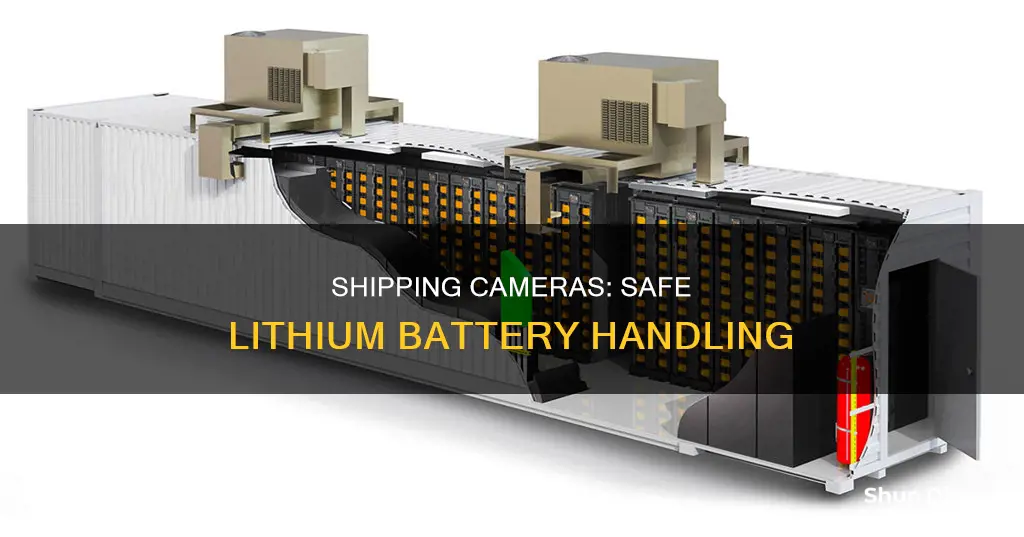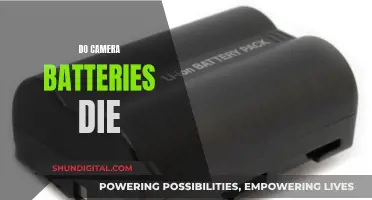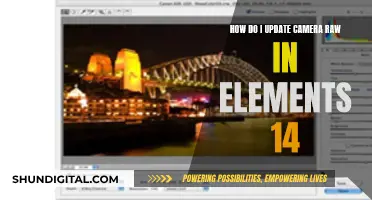
Shipping a camera with a lithium battery requires careful attention to safety regulations. Lithium batteries are considered dangerous goods due to their highly flammable nature and sensitivity to environmental factors, which can pose safety risks if not handled properly. To avoid fines and ensure the safety of personnel, aircraft, and passengers, it is crucial to comply with the applicable shipping regulations. These regulations include specific packaging, labelling, and transportation requirements, as well as restrictions on air shipment for certain types of batteries.
| Characteristics | Values |
|---|---|
| Shipping method | Ground shipping |
| Packaging | Sturdy box with sufficient packing material to prevent damage in shipping |
| Number of batteries | No more than two batteries may be shipped in one package |
| Warning labels | Lithium Ion Battery Safety Document, Lithium Ion Battery Handling Label, Class 9 Lithium Battery Label |
| Shipper | UPS, FedEx, USPS, etc. |
| Weight | Lithium batteries weighing more than 35kg must be approved by the national authority before shipment |
| Defective or damaged | Defective or damaged lithium batteries must not be transported |
| Short-circuiting | Batteries should be packaged to prevent short-circuiting while in transit |
| Transportation | Waste lithium batteries meant for recycling shouldn't be transported by air unless approved by the national authority and airline |
| Documentation | Material Safety Data Sheet (MSDS), UN38.3 Certificate |
What You'll Learn
- Lithium-ion batteries are classified as hazardous material and require specific shipping methods
- Only Hazmat-trained individuals can ship lithium-ion batteries
- No more than two batteries can be shipped in one package
- Cameras with lithium-ion batteries must be packaged in a sturdy box with sufficient packing material
- Lithium-ion batteries must be labelled correctly

Lithium-ion batteries are classified as hazardous material and require specific shipping methods
When shipping a camera with a lithium-ion battery, it is important to comply with the Department of Transportation (DOT) regulations. Unless you are Hazmat trained, it is unlawful to ship lithium-ion batteries via air shipment. Ground shipping is the recommended method.
To ship a camera with a lithium-ion battery, follow these guidelines:
- Use ground shipping and a reputable courier with guidelines in place for shipping lithium-ion batteries.
- Package the camera with the battery inside the battery compartment.
- Do not ship more than two batteries in one package.
- Use a sturdy box with sufficient packing material to prevent damage in shipping.
- Print and attach the required warning labels, such as the Lithium-Ion Battery Safety Document, Lithium-Ion Battery Handling Label, and Class 9 Lithium Battery Label.
- Bring your unsealed package to a shipper who can provide a tracking number, such as UPS, FedEx, or USPS.
- Inform the shipper that a lithium-ion battery is being shipped, as there are strict shipping requirements, including special packaging and labeling.
- Ensure that the package is marked and labelled correctly, clearly stating that it contains lithium batteries or dangerous goods.
It is important to follow these guidelines to ensure the safe transportation of lithium-ion batteries and comply with regulations. Non-compliance can result in fines and put people at risk.
Camera Battery Life: AA Power Explained
You may want to see also

Only Hazmat-trained individuals can ship lithium-ion batteries
Shipping a camera with a lithium-ion battery requires careful adherence to safety protocols. Lithium-ion batteries are considered hazardous materials due to their potential to ignite and cause fires, especially when damaged or defective. As such, only individuals with Hazmat training are qualified to ship them.
The United States Department of Transportation (DOT) classifies lithium-ion batteries as hazardous materials under the Hazardous Materials Regulations (HMR; 49 C.F.R., Parts 171-180). These regulations apply to any material that poses an unreasonable risk to health, safety, and property during transportation. Lithium-ion batteries fall under this category due to their flammable electrolytes, which can ignite under certain conditions such as short circuits, physical damage, or improper assembly.
To ensure safe shipping, Hazmat-trained individuals must follow specific guidelines. Firstly, they must use appropriate packaging and handling methods to prevent batteries from short-circuiting, overheating, or sustaining physical damage. This includes using non-conductive materials, such as plastic, to wrap batteries or cover terminals, and ensuring the packaging is sturdy and rigid to protect the batteries from impact.
Additionally, Hazmat-trained individuals are responsible for accurate labelling and documentation. They must include warning labels, such as the Lithium Ion Battery Safety Document, Lithium Ion Battery Handling Label, and Class 9 Lithium Battery Label. Proper labelling helps identify the hazardous nature of the shipment and provides critical information for safe handling and emergency response.
Furthermore, Hazmat-trained individuals must comply with shipping restrictions, such as using ground shipping instead of air shipment for lithium-ion batteries. They also ensure that the batteries are shipped at a charge of 30% or less of their maximum capacity, as stipulated by the Lithium Battery Shipping Regulations (LBSR).
By entrusting the shipping process to Hazmat-trained individuals, the risks associated with transporting lithium-ion batteries can be mitigated, ensuring compliance with regulations and safeguarding people, property, and the environment.
Charging GH5 Batteries: In-Camera Method
You may want to see also

No more than two batteries can be shipped in one package
When shipping a camera with a lithium battery, it is important to adhere to the relevant regulations. This is because lithium batteries are considered hazardous materials and are therefore subject to strict shipping requirements. One such regulation is that no more than two batteries can be shipped in one package. This rule is in place to ensure the safe transportation of lithium batteries and to comply with the Department of Transportation (DOT) regulations.
If you need to ship more than two lithium batteries, you will need to divide them across multiple packages. Each package must adhere to the relevant safety measures and labelling requirements. It is important to note that shipping lithium batteries by air is subject to additional restrictions. Lithium batteries being shipped by air must be in a state of charge not exceeding 30% of their rated capacity.
To ensure compliance with all applicable regulations, it is recommended to use a reputable courier that has guidelines in place for shipping lithium batteries. These couriers have trained personnel who understand the intricacies of handling and transporting lithium batteries. They can guide you through the process and help you avoid potential fines and penalties for non-compliance.
When preparing your shipment, make sure to package the lithium batteries securely to prevent short-circuiting and accidental activation. Use appropriate inner and outer packaging that is strong and rigid enough to withstand the shocks and mechanical handling during transport. Additionally, clearly label the shipment to indicate the presence of lithium batteries and any associated dangers.
By following these guidelines and adhering to the restriction of no more than two batteries per package, you can help ensure the safe and compliant shipment of your camera with a lithium battery.
Charging Your Panasonic DMC-G6 Camera via USB
You may want to see also

Cameras with lithium-ion batteries must be packaged in a sturdy box with sufficient packing material
When shipping a camera with a lithium-ion battery, it is essential to package it securely in a sturdy box with sufficient packing material. This is because lithium-ion batteries are classified as hazardous materials and require special handling and packaging to comply with safety regulations. Here are some detailed instructions to ensure your camera is packaged correctly:
Firstly, source a sturdy box that is slightly larger than the camera and its accessories. This will provide enough space for packing material to surround the camera and protect it during transit. Ensure the box is made of strong cardboard or similar material that can withstand the weight of other packages that may be placed on top of it.
Next, prepare the interior of the box by lining it with packing material. This can include materials such as bubble wrap, foam, or crumpled newspaper. This layer of protection will help cushion the camera and absorb any shocks or vibrations during transportation.
Now, place the camera inside the box and add more packing material around it to fill any remaining spaces. Ensure the camera is securely positioned and cannot move around inside the box. If the camera has a lens, detach it and place it in a separate compartment within the box or wrap it separately in bubble wrap or a similar protective material.
After the camera is securely positioned, add a final layer of packing material on top to ensure the camera is completely surrounded by protective cushioning. Close the box and securely seal it with packaging tape.
Finally, clearly label the box with the required warning labels, such as the Lithium Ion Battery Safety Document, Lithium Ion Battery Handling Label, and Class 9 Lithium Battery Label. These labels are crucial to inform shipping personnel of the hazardous nature of the package and ensure proper handling.
By following these instructions and packaging your camera with lithium-ion batteries in a sturdy box with sufficient packing material, you can help ensure the safe transportation of your device and comply with the regulations governing the shipping of hazardous materials.
CR123A Batteries: How Long Do They Power Cameras?
You may want to see also

Lithium-ion batteries must be labelled correctly
When shipping a camera with a lithium-ion battery, it is crucial to correctly label the package to comply with regulations and ensure the safety of all personnel, aircraft, and passengers. Lithium-ion batteries are classified as hazardous materials and must be handled, stored, and transported accordingly. Here are some detailed instructions and considerations for labelling:
Firstly, it is important to understand the specific requirements for lithium-ion batteries. These batteries have different labelling requirements than other types of batteries. The labels must comply with the regulations set by the Department of Transportation (DOT) in the United States or the International Air Transport Association (IATA) Dangerous Goods Regulations, depending on the mode of transportation.
The labels should include specific markings and symbols. The lithium battery mark, as specified in the applicable packing instructions, must be displayed on the package. This mark consists of a group of batteries, one damaged and emitting flames, above the UN number for lithium-ion batteries or cells. The symbol should be black on a white or suitable contrasting background, with a red diagonal hatching border. The minimum dimensions for the mark are specified as 100 mm x 100 mm, and it should be printed directly on the outer packaging with sufficient contrast.
Additionally, a Class 9 Lithium Battery Label is required. This label must also include the battery image and can only be used for packages containing lithium batteries. It is important to note that the specific placement and combination of labels may vary depending on the shipping carrier and local regulations.
The labels should also include relevant information such as the proper shipping name, class, and UN number. The UN number for lithium-ion batteries is UN 3480. The labels should also include any special provisions and packing instructions relevant to the shipment.
In some cases, the shipper's name and return address may be required on the outer packaging. It is also important to note that the regulations for labelling lithium-ion batteries may change over time, so it is essential to refer to the latest version of the applicable regulations before shipping.
Lastly, it is worth mentioning that there are specific labelling requirements depending on the quantity of batteries being shipped. If only a small quantity is being shipped, the labelling requirements may be different. It is important to refer to the specific regulations and guidelines provided by the shipping carrier and relevant regulatory bodies.
Charging Your Xiaomi Yi Camera: A Quick Guide
You may want to see also
Frequently asked questions
The camera and battery must be packaged in a sturdy box with sufficient packing material to prevent damage in transit. The terminals of the battery should be protected against short circuits, and the package must be labelled appropriately.
The package must have the following labels affixed: a Lithium Ion Battery Safety Document, a Lithium Ion Battery Handling Label, and a Class 9 Lithium Battery Label.
Yes, but there are stipulations. Lithium-ion batteries can be shipped by air only when installed in the device they are intended to operate. The battery must be inside the camera's battery compartment.
Yes, but in the US, used cameras with lithium batteries must be shipped via ground transportation.
Non-compliance can result in fines, rejection of the shipment, or tragic consequences such as fires or accidents.







